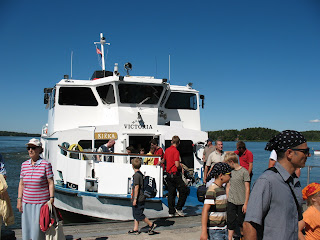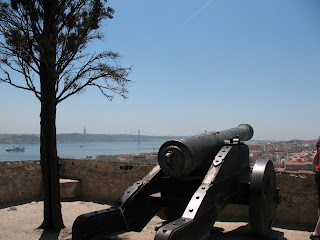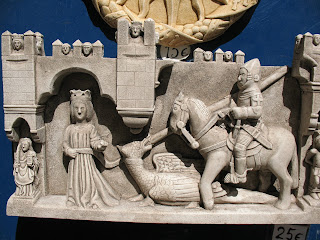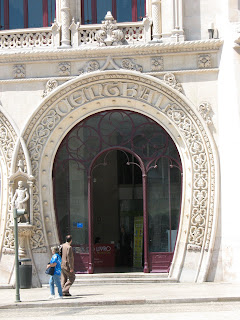There is nothing like too much time in front of a computer just dealing with email to induce severe mind-body dissociation. The L.A. Times had a great story on just that today, but guess how I heard about it -- a daily email alert from them that leads to way much time reading their stories.
Thursday, July 31, 2008
Doing that Cartesian rag
Posted by
Joe Straubhaar
at
7:59 PM
0
comments
![]()
Friday, July 25, 2008
Birka






Posted by
Joe Straubhaar
at
10:00 AM
0
comments
![]()
Labels: http://bp0.blogger.com/_yu_6_7etzFA/SIot3iaew0I/AAAAAAAABFg/ZZeig6p-Rhg/s320/IMG_6766.JPG
Thursday, July 24, 2008
Gamla Stan




Posted by
Joe Straubhaar
at
2:32 PM
0
comments
![]()
Monday, July 21, 2008
Stockholm




Posted by
Joe Straubhaar
at
1:35 PM
0
comments
![]()
Saturday, July 19, 2008
To the furthest west point in Europe
This afternoon, a friend from Lisbon, Cristina Ponte, took us on a drive out to Cabo da Roca, the furthest west point in continental Europe. A breathtaking view on a peak high above the ocean, as you can see from this photo of Cristina and Sandy at the point.



Posted by
Joe Straubhaar
at
3:30 PM
5
comments
![]()
The arcades project

Posted by
Joe Straubhaar
at
3:02 PM
0
comments
![]()
Friday, July 18, 2008
And more Art Nouveau at one of the world's most amazing bookstores
The promotional magazines about cities you find in hotels are usually pretty useless, dedicated to really pointless but expensive consumption. Today in Porto, however, Sandy found a real gem in one: the Livraria Irmãos Lello, a family-run bookstore in the old city that has been in the same location since 1904. Here is the façade, which is pretty impressive as a neo-gothic confection.
It got even better inside. Here is Sandy in the front of the store, with an absolutely amazing staircase rising behind her.
Here is another view of the stai
We loved the place. It made us think of all the Straubies back home who are big Art Deco fans, Julia, Kristy and Chris. It has a great collection of art, literature and travel books, too.
Posted by
Joe Straubhaar
at
1:54 PM
0
comments
![]()
Azulejos

Here is a much more conventional use, showing religious scenes on the side of a church in Porto. We wandered in an caught a lovely impromptu baroque organ music concert, which I hated to leave.
Here is another pretty frequent employment for tiles in Portugal, the celebration of big events in Portuguese history, in this case, the very beginning of Western 
Posted by
Joe Straubhaar
at
1:34 PM
0
comments
![]()
World's Largest and Most Misplaced Doily

Personally, I prefer the art of the kids diving into the river in the summer heat. Looks like a lot of fun. We ate dinner here on the river bank tonight and enjoyed the view despite the vast doily.
Posted by
Joe Straubhaar
at
1:26 PM
0
comments
![]()
Thursday, July 17, 2008
The São Jorge Castle in Lisbon
Along with Jeremiah, one of my grad students from UT, Sandy and I went to the Castelo São Jorge (St. George Castle), which figures prominently on the Lisbon skyline and equally prominent in its history, when Afonso Henriques, the first king of Portugal, took it by siege from the Moors in 1147.
It is interesting how widely revered St. George was across medieval Europe, not just England. Here is a replica of a stone carving of him in Portugal from 1398. And as most Brazilians know, he made it across the Atlantic, just in time to get syncretized with the African god Ogum in candomblé in Brazil.
We took a somewhat circuitous route to the castle. We walked to the base of its hill, then took a streetcar, which wound all over the place, including close to the castle, but the driver refused to tell anybody where to get off for the castle. So a bunch of tourists ended up at the end of the line, several miles away, by a nice park and cathedral (lots of those all over Lisbon).
So finally we took a cab back to the castle, where you can see us, at last in this photo.
The castle has a great view out over the Lisbon skyline. They are supposed to have commanding views, by definition, I suppose. Here is a view of the River Tejo, with what looks like a 16th or 17th century cannon in front.
Posted by
Joe Straubhaar
at
10:18 AM
2
comments
![]()
The Art Deco Tour of Lisbon

The Art Deco façades also combine in a lot of other things. This first one is a building with a corner relief that celebrates cinema and arts. It has been taken over by a Hard Rock Cafe. So all the nice socialist realism, in the Portuguese fascist version, in figures of dance, music, etc. want you to now join Planet Hollywood. Sitting duck for some snarky comments about global hybridity, but too easy.
Here is another example of a cinema arts palace, that has been repurposed. This one
The last one is a train station that is still a train station, but its doors are really interesting. They combine what seems like a classic Art Deco rounded door with a much earlier rounded, decorated arch that mimics a 16th century church door, with the kind of carving that you might have seen on one of Lisbon's cathedrals or monasteries.
Posted by
Joe Straubhaar
at
9:37 AM
0
comments
![]()
Wednesday, July 16, 2008
On the trail of the Pastel de Belem in Lisbon

Here is Sandy, enjoying the breeze and kibitzing in on the research planning.
Posted by
Joe Straubhaar
at
3:06 PM
0
comments
![]()
Tuesday, July 8, 2008
London calling

Here are Sandy and Chris in the classic tourist view along the Thames. A bit wider here than it was at Oxford.
We strolled along the Thames several times day and night. All three of us are art fans and fans of Salvador Dali in particular, so it was fun to run across this massive elephant of Dali's along the Thames.
After walking up the Thames quite a bit we got to the neighborhood of the Globe Theatre where we had tickets to see King Lear. I had always wanted to see Shakespeare at the Globe, so it was quite a thrill. Here are Sandy and I in the third floor balcony.
The next day we went to the Tower of London, which I had somehow or other never been through before. The Yeoman Warders really are pretty amazing as guides go. (And we had seen a lot of museums and guides at that point.) Here is ours who had a fine sense of humor and drama, and crowd control that I can only envy when I teach 450 freshmen next fall.
More London later. Now bed is calling.
Posted by
Joe Straubhaar
at
9:09 PM
0
comments
![]()
Dancing fool

You just have to love the Web for its ability to throw up really random, but delightful things. Below is a video of Matt Harding, from Australia, doing a goofy sort of chicken dance in all sorts of locations around the world. You can see some of them here, including Austin, by the statue/shrine to Stevie Ray Vaughn, which sort of vouches for his taste in music if not dance moves.
Part of the fun of the video is the sheer joy the guy seems to get out of it, as well as the way people, particularly kids, get into it with him. Part of the fun is thinking about those places he dances where you might have been to yourself.
If you want the old school treatment, here is a link to a New York Times story about him. I guess I am still a bit old school myself, since that is how I heard about him. But then I kind of like a nice blend of old and new.
http://www.nytimes.com/2008/07/08/arts/television/08dancer.html?em&ex=1215662400&en=1c9425dc6d0eb3c2&ei=5087%0A
To quote the Times:
"The music (by Gary Schyman, a friend of Mr. Harding’s, and set to a poem by Rabindranath Tagore, sung in Bengali by Palbasha Siddique, a 17-year-old native of Bangladesh now living in Minneapolis) is both catchy and haunting. The backgrounds are often quite beautiful. And there is something sweetly touching and uplifting about the spectacle of all these different nationalities, people of almost every age and color, dancing along with an uninhibited doofus."
Posted by
Joe Straubhaar
at
8:36 AM
0
comments
![]()
Sunday, July 6, 2008
Oxford town

It was great fun, starting with a nice restaurant on the side of the Thames where we had lunch and watched people who had rented punts trying to make them work.
We walked all around town, looking in on a couple of the more famous traditional colleges. Here is Christchurch College.
And here is a courtyard at Magdalen College, where C.S. Lewis was on the faculty. Sandy and I are both long time fans of many of his books, particularly the Narnia series (despite the less than stellar movies). Sandy in particular attributes much of her childhood sense of morality to ideas from the Narnia books. I only encountered them as an adult, but I still like them.
Here is the River Cherwell seen from Addison's walk, in back of Magdalen College, where J.R.R. Tolkien and Hugo Dyson reputedly convinced C.S. Lewis to become a Christian at 3 a.m. on September 20, 1931.
Tolkien's Lord of the Rings trilogy was very magical for both Sandy and me as teenagers. I was wowed by the breadth of the saga, the heroism and goodness of the main characters. Very inspiring stuff. I can't really say that either Tolkien or Lewis directly affected my own evolving sense of morality or my decision as a late teenager to really embrace the Mormon Christianity I had grown up with. But it has been fascinating to learn about how these men thought it through for themselves and talked about it.
On that same theme, here is the pub where Lewis, Tolkien, Charles Williams and Hugo Dyson used to meet: The Eagle and Child, sometimes known as the Bird and the Baby.
And here is a picture of Sandy and Chris inside the pub.
Posted by
Joe Straubhaar
at
9:13 PM
0
comments
![]()
















